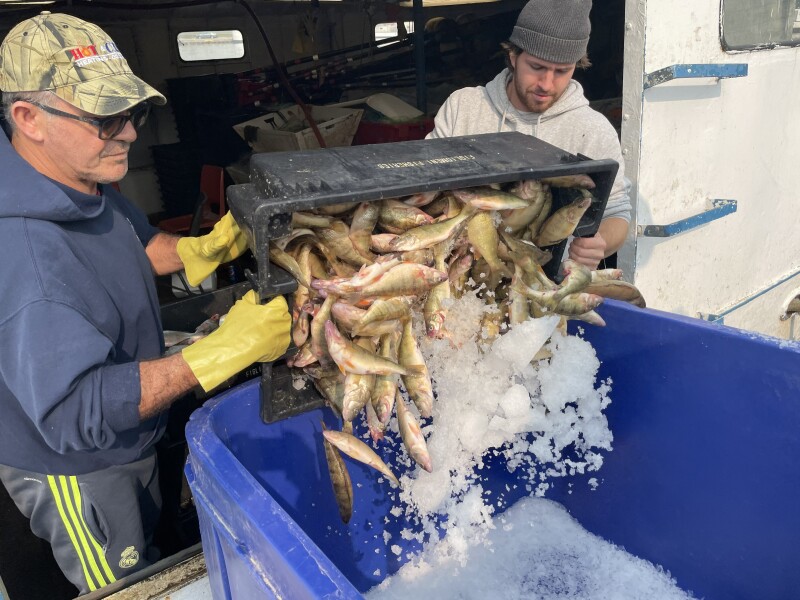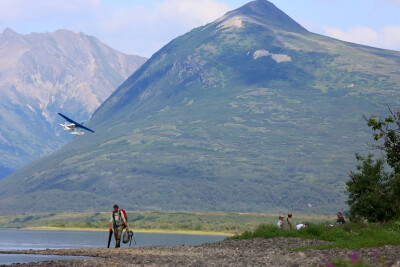Quotas for yellow perch have been cut, but the Figliomeni family is going strong on Lake Erie
“I can speak Italian,” says Figliomeni. “My brother Dante [who has been on the boat for four years] can understand it, but he doesn’t speak as much.” Manuel Antunes and Toze Anastacio speak their native Portuguese, Alfredo López speaks Spanish with the journalist, and all speak English for the benefit of mutual understanding and Brady Rickert, the newest addition to the crew.
Figliomeni runs his engines checks and fires up the Cat C18 main. Although 800 hp might seem like a lot for a boat hauling gillnets at a moderate pace, it comes in handy when the lake freezes. “We need it to break through the ice,” says Figliomeni. “And we’re going to rig up to pull a net for smelt.”
Lines cast and underway, the five-man crew begins to prepare for fishing. Figliomeni threads the needle out of the harbor. “We draw 9 feet,” he says. “At one point here, I have only half a foot under the keel.”
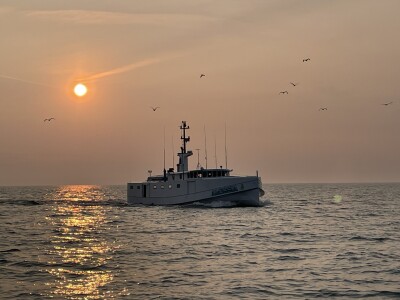
Like all fish tugs, the Francesca Madre has an enclosed deck, as well as a heater for the cold months. A small, elevated wheelhouse pokes out of the roof just forward of amidships, and aft of that the 24-foot wide the boat offers an ample work platform. The United States once had a commercial fleet of its own, with fish tugs working Lake Erie from ports in Ohio, Pennsylvania, and New York. But successive gillnet bans ended the commercial
On the enclosed deck, forward of the wheelhouse on the port side, a horizontal gillnet puller and a roller guide stand just higher than the rail. Rickert, López, and Anastacio slide open a steel panel creating a window from the rail to the roof about ten feet wide. As the chill morning air blows in from the still-dark lake, they pivot the roller for the puller outboard, ready for the first net. On the big deck aft, Dante Figliomeni and Antunes arrange the chairs and boxes they will all, except Rickert, use to pick fish.
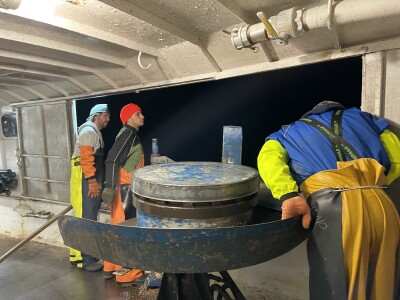
The crew has donned oil pants and thick rubber aprons. “Why the apron?” I ask Antunes. He starts to explain but then just signs to me to wait and watch.
In the wheelhouse Figliomeni studies his Raymarine plotter and Raymarine radar, steering towards the waypoint that marks his first buoy. He has six VHFs but this early in the day they’re all silent. “We did better in the deeper water yesterday, so I moved over a little,” he says. “We set our nets running north south so they bow in the current.”
While the lakes lack any noticeable tides, Filiomeni notes that the waters have many currents. “There’s the bathtub effect,” he says. “If we get wind from the east for a few days it pushes the water up in this end of the lake, and then when the wind stops, woosh, it all goes down to the other end.” He notes also that the general flow of the water down out of the lakes creates eddies going up the other way.
“This time of year, the water’s mixing,” he says. “There’s no thermoclines, so the fish are all mixed together.” He explains how he set his nets so that they would fish close to bottom. “The yellow perch are bottom feeders,” he says. “They eat worms, baby zebra mussels. Usually we set the net open, the guys stand behind the setting wheel and spread it so it fishes about two feet off bottom, but when we’re trying to avoid white perch we close it, we just let it run through the wheel so that it fishes only a foot off bottom.”
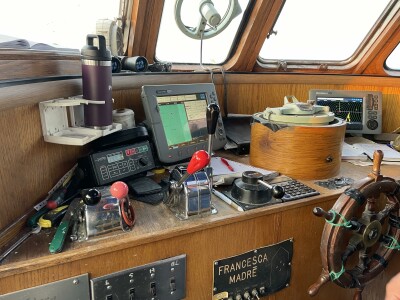
Figliomeni grew up in this business. His grandfather Antonino, for whom he is named, came from Italy in 1967 and worked on the lake boats before buying his own. Figliomena’s father had the Francesca Madre built in 1982 and fished it for 20 years before selling it to his son.
“I’m fourth generation,” he says. “My grandfather’s father was a fisherman in Sicily. What happened was that my grandfather had a boat there and he got blown over to Africa, onto a little island off the coast and they killed his crew and burned his boat, but he was able to get back to Sicily. But he had nothing anymore, so he came over here. He was in Brazil for five years, but his sister was up here and she said, why not come up here, there’s fishing here. So, he came.”
The Figliomeni family now owns four boats and a fish market, The Fish Guys, in nearby Leamington. “My father fishes one, I fish one, my brother fishes one, and the fourth is sort of a spare, but we’re hoping my younger brother can run it eventually. Actually, there’s a video of us doing a commercial for Meijer Seafood.”
The engine hammers and the boat churns forward, sliding through the moonless dark. Eventually Figliomeni throttles back and the crew lean out the opening on the port side hoping to spot the first buoy. They spot a highflyer made of PVC pipe passed through a Styrofoam buoy, with a weight on one end and a numbered flag on the other. Rickert leans out and gaffs it aboard. López and he wrestle through the opening, wrap the line into the puller, and Figliomeni, looking down out of the wheelhouse, opens the hydraulic valve that starts to wind the first anchor up. With the anchor aboard Figliomeni starts to wind the net in. Rickert has placed a shallow plastic tray at the base of the puller and feeds the net into it, along with the gilled yellow perch, white perch, and pickerel (walleye), as well as the occasional sucker.
When he has the tray loaded with gillnet and fish, Rickert grabs a box hook and drags it aft to the pickers, or sometimes López comes forward to get the tray. Dante Figliomeni, Antunes, and Anastacio, the fast pickers sit in chairs lined up along the starboard side. The first box goes to Dante, to the left of his chair, and right away he begins sliding the net smoothly across his apron into an empty tray on his right side, while untangling the fish with lightning speed and tossing them into the appropriate box – perch into one, pickerel into another, white perch into another and white perch too small to keep into another.
As the nets come aboard, Rickert has his hands full and López drags the loaded trays back so that all the pickers, including himself, are all busy. This is why they need the big crews they had explained to me. “You’ll see when we get out there,” Antunes had said the day before. “You have to see it to really understand it. We can’t explain it.”
Steady by the puller, Rickert keeps filling trays. “Each tray holds about five nets,” he says. “It depends on how much fish we’re getting, sometimes only two or three.” Once a tray is full, he quickly unties the last net and feeds the next net into a new tray. “I’m the new guy,” Rickert says. “So, this is my job.”
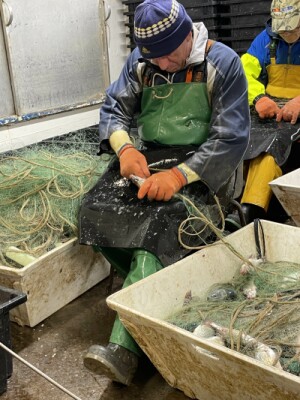
Figliomeni has a total of 4800 yards of net out. “We have three straps,” he says, explaining that a strap contains 50, 96-foot nets tied together. “We get about a year and half out of them,” he says. “It depends. If the current takes them into rocks or zebra mussels, they get torn up. And the pickers, sometimes they break some bars getting the fish out.”
As the puller turns it grabs the net and brings it aboard, sometimes with a few yellow perch, the main target species, and pickerel. The white perch seem to be plentiful, though low priced, and no market at all for the small ones. “Not as good as yesterday,” says Figliomeni. “I should have moved a little further south. I went a little deeper this time, 50 to 51 feet. The thing is this time of year it’s hard. You can move just a few feet and get a lot, but if you’re over here,” he says, indicating a short distance. “There’s nothing.”
With all the nets aboard, Rickert goes aft and opens a window on the stern. Moving into slightly shallower water, Figliomeni give the signal. Rickert tosses a buoy and set an anchor ready to go. The net, tied to the anchor, follows it down. Rickert guides it through the setting wheel while Figliomeni watches him in a rearview mirror. “He’s new so I go a little slower,” he says. “About 3.5 knots. With those other guys I might go 5. But the twine can sometime come up and wrap around your hand.”
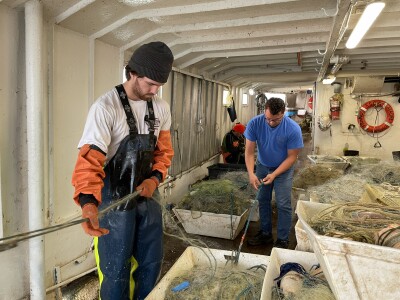
As Rickert sets, Figliomeni runs back frequently to tie nets together and launch buoys and anchors. By 8:30 things are pretty much over. The nets are set again, the crew is finishing up picking through the fish filled nets on deck, and Figliomeni steers a northwest course back to Port Wheatly. “My 5-year-old son comes out here and he loves it,” he says. “I hope we can keep it going for him. When we first went to quota, we got 180,000 pounds. They keep cutting it on us. I have two permits to get 18,000 pounds.”
With four generations of fishing experience, the Figliomeni’s hope to see a fifth generation take over the business. Figliomeni talks to his father and uncle on the VHF in Italian, comparing notes and helping each other. They are a tight family, with an obvious knack for expanding their enterprise and adapting. They belong on the lake, and to the lake.
